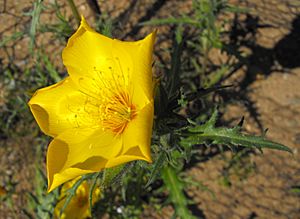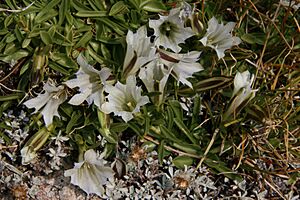List of California native plants facts for kids
California native plants are amazing plants that grew in California before people from Europe arrived in the late 1700s. California is a special place for plants because it has many different types of land, climates, and soils. A big part of California is called the California Floristic Province. This area is known as a "world hotspot" for its huge variety of living things, especially plants!
Scientists believe California has thousands of native plant species. In 1993, one study counted about 4,693 native species and 1,169 native subspecies or varieties. Many of these, about 1,416, are endemic, meaning they are found only in California and nowhere else in the world! This huge plant diversity comes from California's large size and its many different landscapes, weather patterns, and soil types.
Some California native plants are very popular in gardens around the world. For example, beautiful lupines, bright California fuchsias, and the famous California poppies were grown in European gardens for over a hundred years before they became popular in California gardens!
Contents
- Amazing Trees of California
- Cool Shrubs of California
- Plants of the California Desert
- Perennial Plants of California
- California's Beautiful Bulbs
- Annual Wildflowers of California
- Vines of California
- California's Grasses and Grass-like Plants
- Succulent Plants of California
- Protecting California's Plants
Amazing Trees of California
California is home to many incredible native trees, from towering giants to unique oaks.
Giant Conifer Trees
These trees are often called "evergreens" because they keep their needle-like leaves all year.
Sequoias and Redwoods: California's Giants
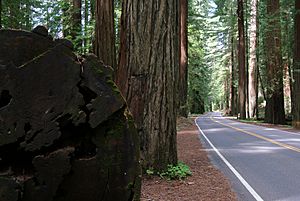
- Coast redwood (Sequoia semperverens): These are the tallest trees on Earth! They grow along the foggy coast. It's the official state tree of California.
- Giant sequoia (Sequoiadendron giganteum): These are the most massive trees on Earth, found in the Sierra Nevada Mountains. They are super wide!
California's Pine Trees

Pine trees are easy to spot with their long needles and cones.
- Bishop pine (Pinus muricata): A coastal pine often grown in gardens.
- Coulter pine (Pinus coulteri): Known for its very large, heavy cones.
- Gray pine (Pinus sabiniana): Also called ghost pine or digger pine.
- Ponderosa pine (Pinus ponderosa): A common and well-known tree in California's mountains.
- Lodgepole pine (Pinus contorta): Its straight trunks were used to build early structures.
- Monterey pine (Pinus radiata): Naturally grows in a small area but is planted all over the world.
- Great Basin bristlecone pine (Pinus longaeva): Home to the "Methuselah" tree, which is over 4,700 years old!
Western Cypress Trees

Cypress trees are known for their dense, often cone-shaped growth.
- Arizona cypress (Cupressus arizonica)
- Monterey cypress (Cupressus macrocarpa): A famous tree found along the coast near Carmel.
- Pygmy cypress (Cupressus pygmaea): A smaller cypress variety.
Other Conifer Trees
- Santa Lucia fir (Abies bracteata): One of eight native fir species in California.
- Douglas fir (Pseudotsuga menziesii): A very common and important timber tree.
- Incense cedar (Calocedrus decurrens): Has flat, scale-like leaves and a pleasant smell.
- Port Orford cedar-Lawson cypress (Chamaecyparis lawsoniana): A beautiful tree often used in landscaping.
- White fir (Abies concolor): Grows at high elevations in the mountains.
California's Oak Trees
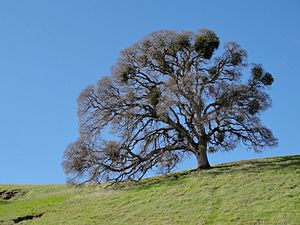
California has many types of oak trees, some that lose their leaves (deciduous) and some that stay green all year (evergreen). They often grow in special "oak woodlands."
- Valley oak (Quercus lobata): This is the biggest of all the California oaks.
- Blue oak (Quercus douglasii): Found in the foothills and along the coast.
- California black oak (Quercus kelloggii): Grows in the higher hills and mountains.
- Coast live oak (Quercus agrifolia): An evergreen oak common along the coast and in many other areas.
Trees Near Water (Riparian)

These trees love to grow near streams, rivers, and other wet places.
- California sycamore (Platanus racemosa): Has peeling bark and large, maple-like leaves.
- Quaking aspen (Populus tremuloides): Its leaves "quake" or tremble in the slightest breeze.
- Fremont cottonwood (Populus fremontii): Another fast-growing tree found by water.
- Arroyo willow (Salix lasiolepis): A common willow found along streams.
Other Interesting Trees and Large Shrubs
- California bay laurel (Umbellularia californica): Has fragrant leaves that can be used in cooking.
- Pacific madrone (Arbutus menziesii): Known for its smooth, reddish bark that peels off.
- Toyon (Heteromeles arbutifolia): A shrub or small tree with bright red berries in winter.
- Bigleaf maple (Acer macrophyllum): Has very large leaves, as its name suggests.
- Western blue elderberry (Sambucus mexicana): Important for birds, butterflies, and other helpful insects.
- California buckeye (Aesculus californica): Has beautiful white flowers in spring.
Cool Shrubs of California

Shrubs are smaller than trees but still play a big role in California's plant life.
- Chamise (Adenostoma fasciculatum): A very common shrub in chaparral areas.
- Manzanita (Arctostaphylos spp.): Known for its smooth, reddish-brown bark and twisted branches.
- California sagebrush (Artemisia californica): Has a strong, pleasant scent.
- California lilacs (Ceanothus spp.): Many different kinds, famous for their beautiful blue or white flowers.
- Flannelbush (Fremontodendron spp.): Has large, bright yellow flowers.
- Creosote bush (Larrea tridentata): A tough desert shrub that can live for a very long time.
- Lupines (Lupinus spp.): Many species with tall spikes of colorful flowers.
- Sages (Salvia spp.): A large group of plants, many with fragrant leaves and attractive flowers.
Plants of the California Desert


The deserts of California are home to many unique plants that can survive in dry conditions.
- California fan palm (Washingtonia filifera): The only native palm tree in California.
- Joshua tree (Yucca brevifolia): An iconic tree-like yucca found in the Mojave Desert.
- Jojoba (Simmondsia chinensis): A shrub whose seeds produce a valuable oil.
- Blue palo verde (Parkinsonia florida): Has green bark and bright yellow flowers.
- Ocotillo (Fouquieria splendens): A plant with long, spiny stems that bloom with red flowers.
- Creosote bush (Larrea tridentata): A very common desert shrub, known for its strong smell after rain.
- Desert agave (Agave deserti): A succulent plant with thick, spiky leaves.
- California barrel cactus (Ferocactus cylindraceus): A large, round cactus.
Perennial Plants of California
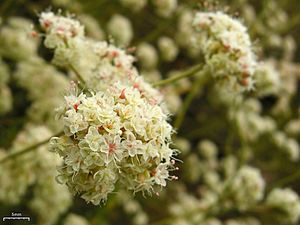
Perennials are plants that live for more than two years, often blooming year after year.
Plants for Sunny Spots
- California poppy (Eschscholzia californica): The state flower of California, known for its bright orange cups. It can also be an annual.
- Douglas iris (Iris douglasiana): A beautiful native iris.
- Monkeyflower (Mimulus spp.): Many different kinds with colorful, often spotted, flowers.
- Columbine (Aquilegia spp.): Delicate flowers with unique spurs.
- Buckwheats (Eriogonum spp.): Many types, providing important food for insects.
Plants for Shady Spots
- Western wild ginger (Asarum caudatum): Has heart-shaped leaves and unusual, low-growing flowers.
- Pacific bleeding heart (Dicentra formosa): Known for its heart-shaped pink flowers.
- Island coral bells (Heuchera maxima): Has attractive leaves and delicate flower spikes.
- Redwood sorrel (Oxalis oregana): Often found growing under redwood trees.
Native Ferns
Ferns are ancient plants that reproduce using spores instead of seeds.
- Polypody ferns (Polypodium spp.): Common ferns found in many habitats.
- Native sword ferns (Polystichum spp.): Like the Western sword fern, which is very common.
- Giant chain fern (Woodwardia fimbriata): A very large and impressive fern.
- Maidenhair ferns (Adiantum spp.): Delicate ferns with black stems.
California's Beautiful Bulbs

Bulbs are underground storage organs that help plants survive dry seasons.
- Ithuriel's spear (Triteleia spp.): Has clusters of blue-purple flowers.
- Goldenstars (Bloomeria crocea): Bright yellow, star-shaped flowers.
- Brodiaeas (Brodiaea spp.): Many different species with lovely bell-shaped flowers.
- Blue dicks-ookow (Dipterostemon capitatus): One of the most common native bulbs in California, found in grasslands.
- Mariposa lilies (Calochortus spp.): Beautiful and delicate lily-like flowers. Remember, it's against the law to pick these from the wild!
Annual Wildflowers of California
Annuals are plants that complete their entire life cycle in one year, from seed to flower to seed.
- Baby blue eyes (Nemophila menziesii): Small, bright blue flowers that carpet the ground.
- Blazing star (Mentzelia lindleyi): Has large, showy yellow flowers.
- California poppy (Eschscholzia californica): The famous state flower, often growing as an annual in many areas.
- Chinese houses (Collinsia heterophylla): Flowers stacked like little pagodas.
- Meadowfoam (Limnanthes douglasii): Forms a white and yellow carpet in wet meadows.
- Miner's lettuce (Claytonia perfoliata): An edible plant with round leaves.
Vines of California

Vines are plants that climb or trail along the ground.
- Dutchman's pipe vine (Aristolochia spp.): Has unique, pipe-shaped flowers.
- Morning glory (Calystegia spp.): Some native morning glories are beautiful climbers.
- Chaparral clematis (Clematis lasiantha): A climbing vine with white flowers.
- California wild grape (Vitis californica): A native grape vine that can grow quite large.
California's Grasses and Grass-like Plants

Grasses are a very important part of many ecosystems, providing food and habitat.
Grasses:
- California fescue (Festuca californica): A common native bunchgrass.
- Purple needlegrass (Nassella pulchra): This is the official state grass of California!
- Deer grass (Muhlenbergia rigens): A tough grass often found near water.
Grass-like Plants:
- Sedges (Carex spp.): Look like grasses but have triangular stems.
- Rushes (Juncus spp.): Also look like grasses but have round stems.
- Western blue-eyed grass (Sisyrinchium bellum): Has small, bright blue flowers, even though it's called "grass."
Succulent Plants of California
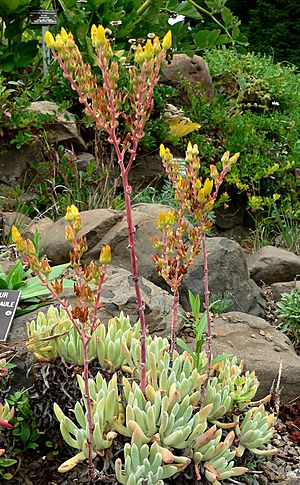
Succulents are plants that store water in their leaves, stems, or roots, helping them survive in dry places.
- Dudleyas
- Chalk lettuce (Dudleya pulverulenta): Often grown in gardens, with leaves covered in a white powder.
- Coast dudleya (Dudleya caespitosa): Found only in California, along the coast.
- Canyon live-forever (Dudleya cymosa): Another popular garden plant.
- Sedums
- Broadleaf stonecrop (Sedum spathulifolium): A small succulent with spoon-shaped leaves.
- Coast sedum (Sedum oreganum): Grows along the coast.
- Feather River stonecrop (Sedum albomarginatum): Found only in California's Sierra Nevada mountains.
Protecting California's Plants
Many native California plants are facing challenges in their natural homes. Things like new buildings, farms, too many animals eating plants, pollution, and plants from other countries (called invasive species) are causing some native plants to disappear.
California also has over 1,000 types of non-native plants. Some of these, like yellow starthistle, cause big problems because they spread quickly and push out native plants. These plants arrived over many years, starting when Europeans first came to California and continuing with trade and new people moving here. It's important to protect California's amazing native plants so they can continue to thrive for future generations!


